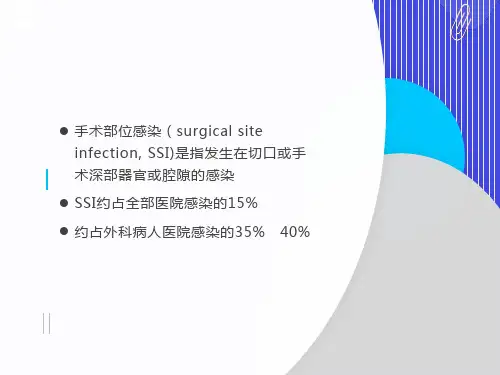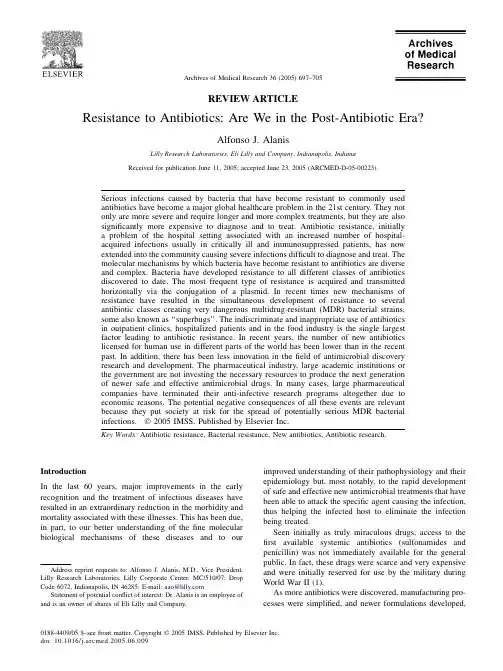万古霉素MIC漂移(Judy)ppt课件
- 格式:ppt
- 大小:641.50 KB
- 文档页数:32










REVIEW ARTICLEResistance to Antibiotics:Are We in the Post-Antibiotic Era?Alfonso J.AlanisLilly Research Laboratories,Eli Lilly and Company,Indianapolis,IndianaReceived for publication June 11,2005;accepted June 23,2005(ARCMED-D-05-00223).Serious infections caused by bacteria that have become resistant to commonly used antibiotics have become a major global healthcare problem in the 21st century.They not only are more severe and require longer and more complex treatments,but they are also significantly more expensive to diagnose and to treat.Antibiotic resistance,initially a problem of the hospital setting associated with an increased number of hospital-acquired infections usually in critically ill and immunosuppressed patients,has now extended into the community causing severe infections difficult to diagnose and treat.The molecular mechanisms by which bacteria have become resistant to antibiotics are diverse and complex.Bacteria have developed resistance to all different classes of antibiotics discovered to date.The most frequent type of resistance is acquired and transmitted horizontally via the conjugation of a plasmid.In recent times new mechanisms of resistance have resulted in the simultaneous development of resistance to several antibiotic classes creating very dangerous multidrug-resistant (MDR)bacterial strains,some also known as ‘‘superbugs’’.The indiscriminate and inappropriate use of antibiotics in outpatient clinics,hospitalized patients and in the food industry is the single largest factor leading to antibiotic resistance.In recent years,the number of new antibiotics licensed for human use in different parts of the world has been lower than in the recent past.In addition,there has been less innovation in the field of antimicrobial discovery research and development.The pharmaceutical industry,large academic institutions or the government are not investing the necessary resources to produce the next generation of newer safe and effective antimicrobial drugs.In many cases,large pharmaceutical companies have terminated their anti-infective research programs altogether due to economic reasons.The potential negative consequences of all these events are relevant because they put society at risk for the spread of potentially serious MDR bacterial infections.Ó2005IMSS.Published by Elsevier Inc.Key Words:Antibiotic resistance,Bacterial resistance,New antibiotics,Antibiotic research.IntroductionIn the last 60years,major improvements in the early recognition and the treatment of infectious diseases have resulted in an extraordinary reduction in the morbidity and mortality associated with these illnesses.This has been due,in part,to our better understanding of the fine molecular biological mechanisms of these diseases and to ourimproved understanding of their pathophysiology and their epidemiology but,most notably,to the rapid development of safe and effective new antimicrobial treatments that have been able to attack the specific agent causing the infection,thus helping the infected host to eliminate the infection being treated.Seen initially as truly miraculous drugs,access to the first available systemic antibiotics (sulfonamides and penicillin)was not immediately available for the general public.In fact,these drugs were scarce and very expensive and were initially reserved for use by the military during World War II (1).As more antibiotics were discovered,manufacturing pro-cesses were simplified,and newer formulations developed,Address reprint requests to:Alfonso J.Alanis,M.D.,Vice President,Lilly Research Laboratories,Lilly Corporate Center,MC/510/07;Drop Code 6072,Indianapolis,IN 46285;E-mail:aao@Statement of potential conflict of interest:Dr.Alanis is an employee of and is an owner of shares of Eli Lilly and Company.0188-4409/05$–see front matter.Copyright Ó2005IMSS.Published by Elsevier Inc.doi:10.1016/j.arcmed.2005.06.009Archives of Medical Research 36(2005)697–705access to antibiotics eased considerably and their use became widespread.Antibiotics had truly become the‘‘panacea’’of medicine and were being used to treat even the most common and trivial types of infections,many of these non-bacterial in nature.Based on the work that he had done in his research laboratory,in an interview with The New York Times in1945, Sir Alexander Fleming warned that the inappropriate use of penicillin could lead to the selection of resistant‘‘mutant forms’’of Staphylococcus aureus that could cause more serious infections in the host or in other people that the host was in contact with and thus could pass the resistant microbe (2).He was right and within1year of the widespread use of this drug a significant number of strains of this bacterium had become resistant to penicillin.Only a few years later over50%were no longer susceptible to this new drug(2).Unfortunately,things have not improved in the recent past.In fact,every day more common and uncommon bacteria,previously susceptible to common antimicrobials, are reported to have developed resistance to different antibiotics.Although these bacteria initially caused signif-icant nosocomial infections and were the cause of major morbidity and mortality in hospitalized patients,more recently they have spread to the community,causing severe illnesses in previously healthy and otherwise non-vulnerable patients.This review tries to provide an overview of the serious problem of antibiotic resistance in the21st century and to begin to open a new window into the complex challenge of new antibiotic development in the future.For this reason, the scope of the article will focus on the problem of bacterial resistance and will not discuss viral,fungal or parasitic resistance.Excellent reviews related on the development and management of resistance of these other microorganisms can be found elsewhere(3–7). Antibiotic Resistance:A Long-Term,Serious Problem...Getting WorseIn order to befit to survive,all living organisms strive to adapt to their environment.Part of this adaptation process includes adjusting to weather conditions,to food,water and in many cases to oxygen availability and also to the presence of potentially dangerous or even lethal external agents.It is no secret that many insects have adapted remarkably well to their environment and so have micro-organisms.Thus it should not be surprising to us that bacteria have shown a remarkable ability to endure and adapt to their environment including the development of different mechanisms of resistance to most old and new antimicrobial agents.The end result of this phenomenon is that many strains of bacteria have become resistant,and in many cases multi-resistant to these therapeutic agents,thus rendering these drugs ineffective as treatments of choice for severe infections caused by these pathogens.As stated earlier,thefirst cases of antimicrobial resistance occurred in the late1930s and in the1940s, soon after the introduction of thefirst antibiotic classes, sulfonamides and mon bacteria such as strains of Staphylococcus aureus became resistant to these classes of antibiotics at record speed.For the most part,during thefirst25years after the introduction of the initial antibiotics,resistance was a problem of hospitalized patients.We learned quickly that these bacteria were not only capable of developing resistance to these antibacterial drugs but that they also could remain alive and viable in the hospital environment, thus affecting mostly vulnerable patients(especially criti-cally ill patients in the intensive care unit,those receiving steroids,the immunosuppressed,the debilitated,the chroni-cally ill and the neutropenic)who were at a higher risk and in whom eventually they caused serious nosocomial infections(8–12).The list of bacteria developing resistance is impressive, from sulfonamide and penicillin-resistant Staphylococcus aureus in the1930s and1940s(2,13)to penicillin-resistant Neisseria gonorrhoeae(PPNG),and b-lactamase-producing Haemophilus influenzae in the1970s,(14–17)methicillin-resistant Staphylococcus aureus(MRSA)and the resurgence of multi-drug resistant(MDR)Mycobacterium tuberculosis in the late1970s and1980s,(18–23)and several resistant strains of common enteric and non-enteric gram-negative bacteria such as Shigella sp.,Salmonella sp.,Vibrio cholerae, E.coli,Klebsiella pneumoniae,Acinetobacter baumanii, Pseudomonas aeruginosa,some of these associated with the use of antimicrobials in animals grown for human food consumption in the1980s and1990s(24–29).Recently we have also witnessed the report of very worrisome cases of previously unthinkable resistance as well as the spread of resistant bacteria outside the hospital causing community-acquired infections.Such is the case for strains of Group A Streptococcus becoming resistant to macrolide antibiotics(30–33),Streptococcus pneumoniae developing resistance to different antibiotic classes,in-cluding penicillin,and causing serious infections(34–41) and more virulent strains of MRSA(due to the expression of certain toxins such as the so-called Panton-Valentine leukocidin)spreading to the community(18–21,42–44),as well as Staphylococcus aureus and Enterococci becoming resistant to vancomycin(45–50).Mechanisms of Antibiotic ResistanceAt least17different classes of antibiotics have been produced to date(Table1).Unfortunately,for each one of these classes at least one mechanism of resistance(and many times more than one)has developed over the years.698Alanis/Archives of Medical Research36(2005)697–705In fact,in some cases these bacteria have been able to develop simultaneous resistance to two or more antibiotic classes,making the treatment of infections caused by these microorganisms extremely difficult,very costly and in many instances associated with high morbidity and mortality(51,52).Thus it seems that the dream that some clinicians had and the predictions that many others made in the middle of the20th century about the future eradication of most common infectious diseases from humanity will be unlikely to be achieved.If anything,recent experience with the emergence of totally new infectious diseases(AIDS,SARS, etc.),and the epidemiological trends of antibiotic resistance observed thus far,tend to indicate that we will continue to move in the opposite direction,towards an environment with an ever-growing number of new infectious diseases and of more common bacteria developing antibiotic resist-ance,more bacteria becoming resistant to several antibiotics at the same time,and some of these bacteria continuing to migrate from the hospital setting to the community. The net result could be even higher morbidity,higher mortality,higher costs,and the potential for the rapid spread of these bacteria and overall a decreasing number of useful antimicrobial agents to combat the infections they cause.Gaining a good understanding of the molecular basis for the development of resistance is important because it allows us to develop new approaches to manage the infections caused by these bacteria and to create new strategies for the development of new treatments against these bacteria.In general,it can be said that bacterial resistance has its foundation at the genetic level.This means that in most cases of bacterial resistance,changes in the genetic make-up of the previously susceptible bacteria take place,either via a mutation or by the introduction of new genetic information.The expression of these genetic changes in the cell result in changes in one or more biological mechanisms of the affected bacteria and ultimately determine the speci-fic type of resistance that the bacteria develops,resulting in a myriad of possible biological forms of resistance (51,52).Below we will review briefly both the genetic and the biological mechanisms of resistance.Genetic Mechanisms of TransmissionThe development of antibiotic resistance tends to be related to the degree of simplicity of the DNA present in the microorganism becoming resistant and to the ease with which it can acquire DNA from other microorganisms.For antibiotic resistance to develop,it is necessary that two key elements combine:the presence of an antibiotic capable of inhibiting the majority of bacteria present in a colony and a heterogeneous colony of bacteria where at least one of these bacterium carries the genetic determinant capable of expressing resistance to the antibiotic(51).Once this happens,susceptible bacteria in the colony will die whereas the resistant strains will survive.These surviving bacteria possess the genetic determinants that codify the type and intensity of resistance to be expressed by the bacterial cell.Selection of these bacteria results in the selection of these genes that can now spread and propagate to other bacteria(51).Resistance to antibiotics can be natural(intrinsic)or acquired and can be transmitted horizontally or vertically. Whereas the natural form of antibiotic resistance is caused by a spontaneous gene mutation in the lack of selective pressure due to the presence of antibiotics and is far much less common than the acquired one,it can also play a role in the development of resistance.For the most part,however,the micro-ecological pressure exerted by the presence of an antibiotic is a potent stimulus to elicit a bacterial adaptation response and is the most common cause of bacterial resistance to antibiotics(52). Susceptible bacteria can acquire resistance to antimicrobial agents by either genetic mutation or by accepting antimi-crobial resistance genes from other bacteria.The genes that codify this resistance(the‘‘resistant genes’’)are normally located in specialized fragments of DNA known as trans-posons(sections of DNA containing‘‘sticky endings’’), which allow the resistance genes to easily move from one plasmid to another(52).Some transposons may contain a special,more complex DNA fragment called‘‘integron’’,a sitecapableofintegrating different antibiotic resistance genes and thus able to confer multiple antibiotic resistance to a bacteria.Integrons have been identified in both gram-negative and gram-positive bacteria,and they seem to confer high-level multiple drug resistance to the bacteria that carry and express them(51).Table1.Major antibiotic classes by mechanism of action* Mechanism of action Antibiotic familiesInhibition of cell wall synthesis Beta-lactams(penicillins,cephalosporins, carbapenems,monobactams);glycopeptides; cyclic lipopeptides(daptomycin)Inhibition of protein synthesis Tetracyclines;aminoglycosides; oxazolidonones(linezolid);streptogramins (quinupristin-dalfopristin);ketolides; macrolides;lincosamides,Inhibition of DNAsynthesisFluoroquinolonesInhibition of RNAsynthesisRifampinCompetitive inhibitionof folic acid synthesisInhibitionSulfonamides;trimethoprimMembrane disorganizingagentsPolymyxins(Polymyxin-B,Colistin)Other mechanisms Metronidazole*Modified from Levy SB and Marshall B(51).699Antibiotic Resistance:Post-Antibiotic Era?Once a genetic mutation occurs and causes a change in the bacterial DNA,genetic material can be transferred among bacteria by several means.The most common mechanisms of genetic transfer are conjugation,transformation and transduction.Conjugation.Conjugation is the most important and the most common mechanism of transmission of resistance in bacteria.This mechanism is normally mediated by plasmids (circular fragments of DNA)that are simpler than chromosomal DNA and can replicate independently of the chromosome.The mechanism of transmission of plasmids among bacteria is via the formation of a‘‘pilus’’(a hollow tubular structure)that forms between bacteria when they are next to each other,thus connecting them temporarily and allowing the passage of these DNA fragments. Transformation.Transformation is another form of trans-mission of bacterial resistance genes and takes place when there is direct passage of free DNA(also known as ‘‘naked DNA’’)from one cell to another.The‘‘naked DNA’’usually originates from other bacteria that have died and broken apart close to the receiving bacteria.The receiving bacteria then simply introduce the free DNA into their cytoplasm and incorporate it into their own DNA. Transduction.Transduction is a third mechanism of genetic transfer and occurs via the use of a‘‘vector’’,most often viruses capable of infecting bacteria also known as ‘‘bacteriophages’’(or simply‘‘phages’’).The virus con-taining the bacterial gene that codifies antibiotic resistance (the‘‘resistant DNA’’)infects the new bacterial cell and introduces this genetic material into the receiving bacteria. Most times,the infecting bacteriophage also introduces to the receiving bacteria its own viral DNA,which then takes over the bacterial replication system forcing the cell to produce more copies of the infecting virus until the bacterial cell dies and liberates these new bacteriophages, which then go on to infect other cells.Biological Mechanisms of ResistanceWhichever way a gene is transferred to a bacterium,the development of antibiotic resistance occurs when the gene is able to express itself and produce a tangible biological effect resulting in the loss of activity of the antibiotic. These biological mechanisms are many and varied but they can be summarized as follows.Antibiotic destruction or antibiotic transformation.This destruction or transformation occurs when the bacteria produces one or more enzymes that chemically degrade or modify the antimicrobial making them inactive against the bacteria.This is a common mechanism of resistance and probably one of the oldest ones affecting several antibiotics but especially b-lactam antibiotics via the bacterial pro-duction of b-lactamases(53).Antibiotic active efflux.Antibiotic active efflux is relevant for antibiotics that act inside the bacteria and takes place when the microorganism is capable of developing an active transport mechanism that pumps the antibiotic molecules that penetrated into the cell to the outside milieu until it reaches a concentration below that necessary for the antibiotic to have antibacterial activity.This means that the efflux transport mechanism must be stronger than the influx mechanism in order to be effective(54).Efflux was first described for tetracycline and macrolide antibiotics (55,56)but is now common for many other antibiotics such asfluoroquinolones(52,54).Receptor modification.Receptor modification occurs when the intracellular target or receptor of the antibiotic drug is altered by the bacteria,resulting in the lack of binding and consequently the lack of antibacterial effect.Examples of this mechanism include modifications in the structural conformation of penicillin-binding proteins(PBPs)ob-served in certain types of penicillin resistance,ribosomal alterations that can render aminoglycosides,macrolides or tetracyclines inactive,and DNA-gyrase modifications resulting in resistance tofluoroquinolones(51,52).It is likely that more and newer biological mechanisms of resistance will develop in the future.One can only hope that as these appear,we will be able to use these new mechanisms as new targets for the development of newer, effective antibiotics.What Leads to the Development of Antibiotic Resistance?Different factors play a role in the development of antibiotic resistance but what exactly determines that some bacteria become resistant to a specific drug and not to others and what is the specific role and the‘‘relative weight’’of each one of these factors in this process remains to be defined(Table2).Our understanding of how bacteria adapt to their environment and how this process may culminate in the development of resistance against one or more antibiotics is,at best,incomplete.We are only beginning to un-derstand,at the molecular level,what steps take place for this process to occur and need to continue to gain a much better,more detailed understanding of the specific molec-ular mechanisms that serve as‘‘trigger signals’’for this process of adaptation to ultimately occur.For example,why after more than60years Group A b-Streptococcus continues to be exquisitely susceptible to penicillin but not always to erythromycin?And why other members of the Streptococcus family,such as Streptococcus pneumonia,after many decades of remaining susceptible to penicillin are now capable of presenting high-level700Alanis/Archives of Medical Research36(2005)697–705resistance to penicillin?Why after nearly30years of exhibiting high degree of susceptibility to vancomycin, Staphylococcus aureus developed resistance against this drug?Answering questions like these may help us to not only understand better thefine mechanisms that lead to bacterial resistance but also to develop strategies that result in the better design of new antibiotics that exhibit a long-term degree of activity against bacteria.In practice,however,some correlations suggest a strong association between specific patterns of antibiotic use,the type and duration of exposure,and the development of resistance.Abuse in the Use of Antibiotics in Clinical Practice Results in‘‘Selective Pressure’’The use of antibiotics in humans results in‘‘selective pressure’’in the host receiving the antibiotic.The broader the spectrum of activity,the higher chances for bacteria to develop resistance(57,58).Third-generation cephalosporins,fluoroquinolones and more recently azithromycin have been linked to these problems(58).The net result is that after the administration of the antibiotic,most susceptible bacteria in the host,the majority of which are part of the normal saprophytic bacteria colonizing that individual,are elimi-nated thus selecting only those resistant bacteria capable of surviving despite the presence of the antibiotic.The natural consequence of this selection process is that there is excessive growth of one or more resistant strains.In this way,the host becomes a reservoir of resistant bacteria that can cause an infection in this very individual or they can easily spread to other hosts causing serious infections in the most debilitated ones(59–63).It is for these reasons that antibiotics should be used very cautiously and should be prescribed only to those individuals in whom their use is clearly justified and when it clearly outweighs the potential risks,including the risk of the development of resistance.Unfortunately,in today’s healthcare system where physicians have only a few minutes to fully evaluate a patient,make a diagnosis and prescribe a treatment,and given the increasingly litigious nature of society,physicians frequentlyfind themselves under tremendous pressured to prescribe an antibiotic even when this may not be appropriate.In general,it is worth reminding the clinician that it is necessary to be far more selective and,when an antibiotic is prescribed,it should be the one with the narrower spectrum of activity.Unfortunately,the problem of antibiotic resistance has spread all around the world and in fact it is affecting poor and developing nations much harder than developed countries.This is due to the fact that antibiotics are much easier to obtain without a prescription in many of these countries whereas their access is much more limited in the developed world.The consequence of this is that poor and very poor countries face yet another challenge of immense propor-tions.They will have to educate physicians and their populations to be cautions with the use of these drugs and they will have to face the dire economic consequences of facing the problem of antibiotic resistance.This means that a significant number of people will likely die in these poor nations because their health services will not be able to afford the level of sophistication and expenditure that their complex infectious diseases require.It also means that it is quite likely that in these countries the spread of community-acquired infections due to multi-resistant microorganisms will be broad and will likely serve as the reservoir from which these bacteria will migrate to other regions. Agricultural and Animal Use of Antibiotics Antibiotics are frequently used in animals as part of the process used to manufacture food,especially meats.This is a non-therapeutic use of very valuable drugs and for this reason they should be preserved for use under very special circumstance only(28,29).Recent interactions between regulatory authorities and the food-producing industry in the U.S.are resulting in commitments to reduce and eventually eliminate the use of common antibiotics for non-therapeutic use.Looking at the Future:Is This the Post-Antibiotic Era? The problem of the explosive growth in the development of antimicrobial resistance in the last two decades has only been made worse by a significant and steady decrease in the number of approvals of new antibacterials in the last10–15 years(Figure1)(64).The different forces contributing to this major paucity in the pace of antibiotic innovation are multiple,very complex and interlinked,and much has been written about these inTable2.Risk factors for the development of antibiotic resistance Practices associated with the development of antibiotic resistance Excessive and irrational over-utilization of antibiotics in outpatient practice and in hospitalized patients,either therapeutically or prophylacticallyUse of antibiotics in agricultural industry,particularly in the production of foodLonger survival of severely ill patientsLonger life expectancy with increased use of antibiotics in the elderly. Advances in medical science have resulted in the survival of many patients with severe illness and at risk for infections:Critically ill patientsImmunosuppressionCongenital diseases(i.e.,cysticfibrosis)Lack of use of proven and effective preventive infection control measures such as hand washing,antibiotic usage restrictions and properisolation of patients with resistant infectionsIncreased use of invasive proceduresIncreased use of prosthetic devices and foreign bodies amenable to super infection with resistant bacteria 701Antibiotic Resistance:Post-Antibiotic Era?recent times (64–73).When analyzed individually,these forces seem to have merit on their own weight but they do not appear to be insurmountable.However,when com-bined,they seem to have had a multiplier effect that has now resulted in the creation of a crisis of major proportions which some predict may have unforeseen and dramatic consequences (65).Some of these key obstacles are explained as follows.Tradeoffs Have Been Made within Anti-Infectives Therapeutic ClassThe emergence of new,life-threatening infectious diseases,especially AIDS,has created significant and unexpected needs for the discovery and development of new safe and effective anti-HIV drugs that are capable of prolonging and improving the life of those infected with the virus and of containing the spread of this global disease.Research in this area has taken place in record time and new targets have been unfolded quite rapidly.The result of this has been the discovery and the development of a significant number of truly life-saving antiretroviral agents that when used in appropriate combinations to treat patients suffering from AIDS are literally able to keep these patients alive for years and to resume as normal a life as possible.These successes,however,have created significant internal pressure within pharmaceutical companies since these normally develop their R &D budgets by Therapeutic Area.This means that in most companies that have a Division of Infectious Diseases,the budget for anti-infectives is limited (as is the budget for other therapeutic groups),and in recent years a significant amount of the anti-infective investments made in the industry have been directed to new antiretroviral agents at the expense of other antimicrobials,especially antibiotics.To illustrate this point one only needs to see what has happened in the U.S.in recent years in the field of anti-infectives.From 1998to 2003only nine antibacterials were approved in the U.S.by the Food and Drug Administration(FDA)and of these only two (Daptomycin and Linezolid)had truly novel mechanisms of action.During the same time,nine anti-HIV agents were approved,four of these in 2003alone.Thus,from 1998to 2003the number of antibacterials developed by large pharmaceutical compa-nies and approved in the U.S.by the FDA was the same than the number of new anti-HIV drugs made available to patients with AIDS (64).Antibacterial research productivity has been lower than expected and there has been higher attrition in the pipeline of new antibiotics.Simply speaking,the new technologies such as genomic research,combinatorial chemistry and throughput screening,once heralded as capable of yielding a large number of novel targets amenable to modulation via their interaction with new drugs,have thus far failed to deliver on their promise in the field of antibacterial discovery and research (65).The consequence of this is that no new antibiotic classes have been discovered through the use of these new techniques and thus we continue to face the same barrier than before,the need for new antibacterial platforms for the delivery of new products (65).Additionally,my observation is that in the last decade,the pharmaceutical industry has stopped the development of a significant number of new antibacterial molecules at different stages of progress because these did not meet their expectations due to a wide variety of reasons including manufacturing problems,safety concerns,lower efficacy than expected,or simply due to economic considerations.The result is that the development of these drugs was terminated,thus reducing the overall number of molecules in the antibiotic pipeline.Iterations over ‘‘traditional’’antibacterial chemical structures have been nearly exhausted.It is extremely unlikely,if not impossible,that incremental change that produces new iterations over these old chemical structures will yield the innovative,safe and effective new antibiotics that society needs.The field of antibacterial research is literally ‘‘crying’’for transformational change.This means that in order to produce radically different and novel antimicrobials,we need to be capable of approaching the problem with a fresh and different view which results in truly innovative ‘‘platforms,’’totally unrelated to the old ones.Only experimenting with new targets,new bacterial biological processes and new mechanisms of action we will be able to produce the next new classes of antibiotics,with the desired potency,the right spectrum of activity,the expected therapeutic effect and a clean safety profile,capable of withstand the threat of multi-resistant bacteria.However,as we have learned from other therapeutic areas such as neurosciences,oncology or cardiovascular diseases in recent years,we need to understand that the creation of these novel platforms will be far more resource intensive,far more expensive and it will take a significantly longer time to be developed than those needed forthe24681012141618N o . N e w A n t i b a c t e r i a l A g e n t sFigure 1.New antibacterial agents approved by the FDA in the U.S from 1983to 2003.Data from Reference 70.702Alanis /Archives of Medical Research 36(2005)697–705。
